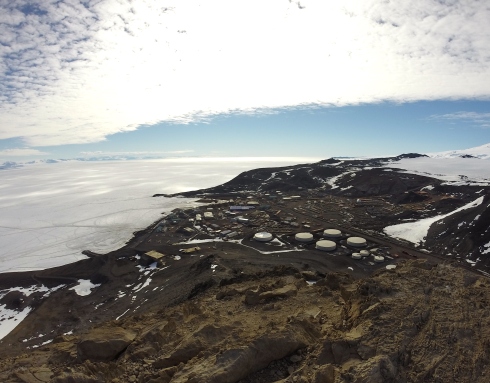You are currently browsing the monthly archive for January 2015.
Diana Wall first came down to the ice in 1989 to study nematodes in Antarctic soils. At the time, no one thought that anything was living in the Dry Valley soils – they were dry, salty, and no plant life could be seen – how could animals be living belowground? That year, Diana came to Antarctica with her colleague, Ross Virginia (Dartmouth College), on a grant to explore those supposedly “sterile soils”. And they found nematodes! Diana said that they had a two-year grant for their study, but at the time they did not know if they would get a second field season. Successfully finding the nematodes living in the cold, dry desert soils was a major feat and paved the way for the next two decades of Antarctic research.
When McMurdo Dry Valleys joined the National Science Foundation’s Long Term Ecological Research network five years later in 1993, Diana was one of the founding Principal Investigators (PI) on the project.
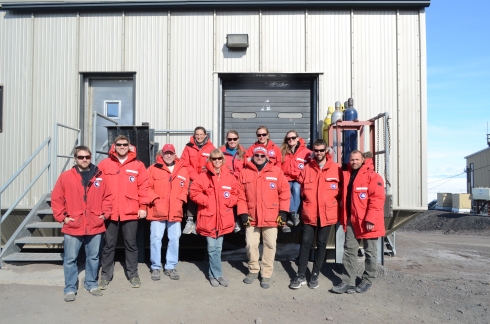
The 2014-2015 Soils Team in front of the Crary Lab loading dock. (Top row (Left to right): Ruth Heindel, Ashley Shaw, Tandra Fraser, Jess Trout-Haney; Front row (left to right): Eric Sokol, Andy Thompson, Berry Lyons, Diana Wall, Byron Adams, Matt Knox, and Zach Aanderud). Photo: Kathy Welch
For 25 years, Diana has shared her Antarctic experiences and science with numerous fellow researchers, students and postdocs. Many things have changed over the years. Diana says, “The Crary lab facilities are fantastic for polar research compared to the old Bio Lab. The field camps for science have improved our ability for real time measurement of biodiversity. And, after all, the Coffee Bar is a GREAT improvement over the old, smoky Officers’ club!”
This year we celebrated Diana’s 25-year anniversary of working in Antarctica! Berry Lyons (Ohio State University) arranged for a cake, got us all organized (that’s a magnificent feat in itself), and we surprised Diana with a celebration in the Crary Library. Congratulations, Diana!
Written by: Ashley Shaw
One of the questions you may have asked yourself when reading this blog is an obvious one. Why would you go to Antarctica to do research on soils? Well, there are many interesting scientific questions to explore here, but I’ll explain a couple of key reasons why we choose Antarctica. First of all, because of the harsh climate in Antarctica—it is the coldest and driest continent—the number of life forms that can survive here is very limited. This means that we are actually able to study all the major players and their interactions in the soil here. This is very difficult in other places around the world, where soils contain many different species that not only interact with each other but also with the plants that are rooted in those soils, extracting water and nutrients from it and returning leaf litter that is in turn decomposed and converted back into nutrients. By studying these relatively “simple” soil ecosystems we hope to get a better understanding of some of the fundamental processes in soils. This in turn will help scientists to get a better insight into more complex soil communities’ functions. The fact that Antarctic soils are a simple ecosystem also makes them very suitable to test the effects of disturbance on the soil food web.
This brings us to a second reason why we choose Antarctica as a place of study. Here in the Dry Valleys the short Antarctic summer brings temperatures that are above freezing. This means that the life forms that live here are very well adapted to cold and drought, but also have to deal with the short warmer summer period. If the temperature increases by even one degree celsius, this immediately translates into the melt of a large amount of ice from glaciers and permafrost, which can cause drastic changes in the landscape. All this makes the Dry Valleys an ideal place to study the effects of climate change on the life in soils. By studying a system that potentially shows large reactions to small changes, we can learn about the general mechanisms by which climate change affects ecosystems.

The edges of Lake Fryxell are melting as the summer reaches its peak. In the distance the Canada Glacier comes down from the Asgard Range.
In addition, the wetting of the landscape can occur by two different methods that will influence other processes in the valleys. Aboveground water flow from glaciers and snowpack can carry surface soils, their salts and nutrients and the organisms within them from higher up in the valley to lower elevations and the lake margins. Melting permafrost can cause large seep areas, with moisture connecting large patches of the soil system together and permitting movement of the soil organisms across the area more easily than normal. If these conditions persist over time, we may also see portions of the valley shift from their normally dry state into one which includes more surface algae and patches of moss. This increase in productivity may result in shifts in the animal distributions across the valley, and being able to capture these shifts as they occur will provide us with insights into landscape-level process changes due to climate change.
So which organisms live in such an inhospitable place? When you arrive in the Dry Valleys, you would initially think that there is really no life at all. You see no plants, you see no animals running around. But underneath the soil surface life abounds. Most of this life is represented by the very smallest forms such as bacteria and protozoa. In places where melt provides a source of water some algae and mosses can be found. Different multicellular animals live here also; nematodes such as Eudorylaimus and Plectus, rotifers and tardigrades (also called water bears). But these wet, algal habitats are relatively scarce, and the vast majority of Dry Valley soil is very dry and salty, rendering it unsuitable most organisms. Here, one very hardy creature thrives. Its name is Scottnema lindsayae, a nematode named after the British explorer Robert Falcon Scott, and is only found in the Dry Valleys. One of the questions we are trying to answer is what happens to Scottnema when soils get warmer and wetter. Will we one day lose this unique Antarctic nematode, the “lion of the Dry Valleys”, altogether when the climate keeps changing?

This tardigrade or water bear was observed piercing the body of a nematode. However, we currently do not know how general this sort of interaction is in the field. Photo: Martijn Vandegehuchte
Written by: Ashley Shaw
Over the past few days, we have been in the field taking full advantage of the small windows of good weather to collect our data and take our samples. And we have had several successful days of fieldwork throughout the last week. Last Saturday, two groups were deployed to two sites in Taylor Valley. One group – Zach, Byron, and Nicoletta (our Italian colleague) – visited Hjorth Hill near the New Harbor site at the mouth of Taylor Valley to set up a moss and lichen study. They went there searching for mosses so that they could help Nicoletta establish some experimental plots. These plots are a continuation of a moss and lichen study that has been set up across Victoria Land, Antarctica. The group had 30 minutes of recon with the helicopter to help them find a good spot for the study. They spotted Hjorth Hill from the air and once on the ground they found that it was full of interesting mosses! Most of the time they were there, the weather was pretty bad, but, luckily, windows of good weather opened up when the helicopter dropped them off and when it came to pick them up.
Check out the video that Byron took of Zach blowing sediment off of the moss beds, revealing a vibrant green carpet underneath. Is the sediment insulating the moss?
The other group – Matt, Ashley, Tandra, and Andy, went to the South side of Lake Bonney to complete treatment of the stoichiometry experimental plots (which you can read about here) and brought back 6 BEE control plots at Bonney. They had a wonderful day in the field, but they are all happy to be finished lugging 25lb jugs of water around! It was snowing while they were there, adding to the chilly ambiance of Antarctic work!

We were surprised to see so much snow covering the valley floor on Saturday. It’s a rare sight this late in the season. From this view, you can see Lake Fryxell as we fly up valley. Photo: Ashley Shaw
On Monday, Byron, Ashley, Tandra, and Matt went to the South side of Lake Hoare in Taylor Valley where several of our experiments and sampling plots are located. We took samples from the BEE plots (read about that experiment here) and from the elevational transect (ET) study while Byron serviced the meteorological station.
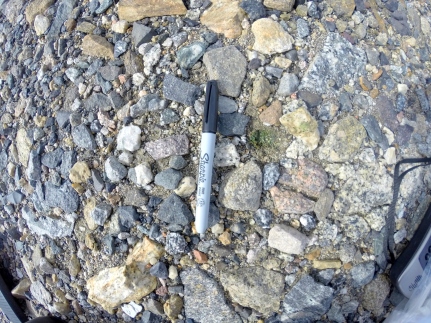
Life endures! Flipping over rocks at the high elevation site, Ashley finds cyanobacteria that are vibrant green. Growing underneath of the rocks provides some shelter and slightly warmer temperatures, even some light passes through the thin pieces of rock. Photo: Ashley Shaw
The elevational transect study began in 1993. The purpose of this study is to see how elevation and topography affects soil life and soil properties, and how this changes over time. The number of soil nematodes, rotifers and tardigrades has been measured at 3 elevations (83, 121, and 188m above sea level) every 2-4 years since 1993 along with soil chemistry, moisture, and primary production. This long-term record is very valuable and helps us to monitor how changes (such as increased temperature, solar radiation, and moisture) impact the ecosystem. Additional elevational transect studies were added in Garwood and Miers Valleys in 2012. But more on those newer transects later…
The elevational transect at the South side of Lake Hoare begins low on the slope near Lake Hoare and near the helo pad where we were dropped off. But to reach the higher elevation sites, one must hike up the steep slope to the south. It’s quite a climb, but the view from the top is a great reward!
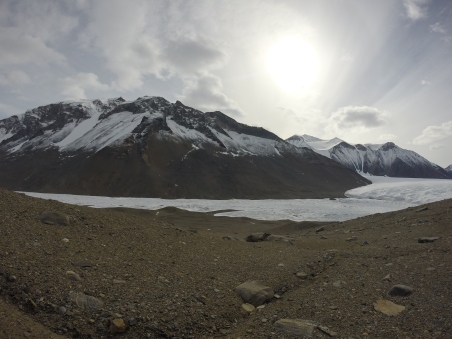
View from the top elevation of the ET in Taylor Valley. You can’t tell from this picture, but we are way high on the slope! What a hike! Whew! Photo: Ashley Shaw
Written by: Ashley Shaw
Hurray!!! We made it to the field yesterday! We are very happy scientists!

In the helicopter on the way to F6, we passed over the icebreaker, USCGC Polar Star. This ship is cutting a channel for the resupply vessel to reach McMurdo Station in a few weeks. It’s amazing that the ship can break through several meters of sea ice! Also, you can see one of our stoichiometry treatment carboys (lower right corner) safely tucked away in the helicopter. Photo: Ashley Shaw
Yesterday, Tandra, Andy, Matt, and Ashley went to F6 near Lake Fryxell to apply treatments to the stoichiometry experiment. It took us a little over two hours to complete our mission. First, we carried the full carboys from the helo pad to the plots. And at 25lbs per carboy, they get heavy! After setting up all of our supplies near our experiment plots, we carefully filled the pouring containers with the correct nutrient treatment. Then, we slowly applied the nutrient solutions to the correct treatment plots. After each one has been poured out onto the correct plot, the pouring container has to be refilled and poured out again on the next plot! We do this 8 times for each treatment (48 times!), because each of the 6 treatments that requires pouring has 8 replicates.
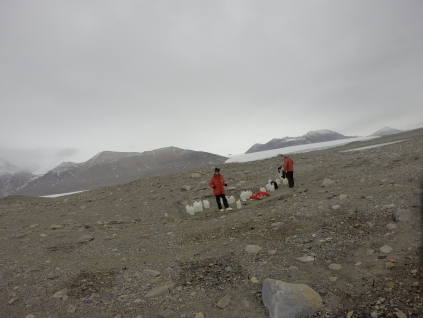
At the stoichiometry plots at F6 yesterday. Matt (L) is happy that we’re out in the field and getting some work done. Andy (R) prepares supplies for the treatments. If you look closely, you can see the plots that have already been treated (they’re wet!) and the stakes that mark the plots. Photo: Ashley Shaw
Today, Byron, Zach, and one of our Italian colleagues are on standby to visit New Harbor at the mouth of Taylor Valley for an algae and moss project. Tomorrow, Ashley, Andy, Matt, and Tandra are heading to South side Lake Bonney to treat the second set of stoichiometry plots and to sample the BEE control plots (read about that experiment here).
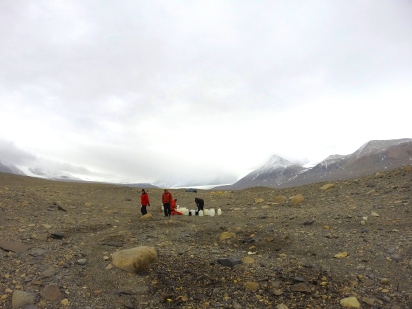
We got some help from the Artist-in-residence, Lily (far-right). She and Matt (right-center) are filling the containers. Tandra (left) heads out with a full pouring container to treat one of the plots, Andy (left-center) waits for the next pouring container. Photo: Ashley Shaw
Written by: Ashley Shaw
The weather was better yesterday, but we still did not get out of McMurdo Station due to the backlog of helo flights from Friday and over the weekend. We are on the helicopter manifest for today, but now it’s snowing, windy, and there’s low visibility. If some nicer weather returns this afternoon, we may still get to the field today.
Later today (or maybe tomorrow), we will be going to the F6 site near Lake Fryxell to treat the stoichiometry experiment. The stoichiometry experiment was designed to help understand which elements are the most limiting to Antarctic soil communities. Additionally, this experiment looks at how landscape history (both Nitrogen deposition and Phosphorus weathering) affects the response of soil organisms to nutrient additions. We have two contrasting sites: Fryxell lake basin and Bonney lake basin. At the Fryxell site (that will be treated today), soils have high native Phosphorus content, but low Carbon and Nitrogen. Contrastingly, the Bonney site soils have high native Nitrogen content, but low Carbon and Phosphorus. We plan to go to Bonney for treatment in a few days.
Treatments are:
- Control – nothing added
- Control – water added
- Nitrogen added
- Phosphorus added
- Carbon added
- Carbon and Nitrogen added
- Carbon and Phosphorus added
First we prepared all of the treatments described above in the lab. This consists of filling carboys with water plus the nutrient that needs to be added. We take these out to the field with us and add these solutions to the treatment plots.

Prepared stoichiometry treatments line the hallway of the Crary Lab waiting to be deployed to the field. Photo: Ashley Shaw
Next week, some people from our group will head back out to Fryxell and Bonney to measure soil respiration, or the amount of CO2 coming out of the soils. This gives us an idea of the level of biological activity in the soil and the treatment effects on this biological activity.
Written by: Ashley Shaw
Working in the dry valleys requires that we travel from station to our field sites by helicopter. There aren’t any roads, there’s a giant field of sea ice between the dry valleys and McMurdo Station, and time is extremely valuable. So, (to my everlasting delight) we travel by helicopter.

(L-R): Diana, Matt, and Ashley in the helo on the way to sample the P3 experiment. Photo: Tandra Fraser
Our helicopter flights were canceled on Saturday, leaving half of our team grounded on station and a few others stuck out in the field. Those of us on station are a little envious of those stuck in the field. Being ‘stuck in the field’ is not as extreme as what you are thinking… Ok, so the helicopter is not coming back to get you today. That means that you stay at the field camp, which is complete with a kitchen, plenty of food, fresh water, electricity, phone, and even internet. And you have access to the experiments that need sampling, observation, and treatment. Yes, being in the field is the best place to be!
For the group still in McMurdo, we are coming to a stalemate. All the possible lab work has been completed. Data has been entered, checked, rechecked. We’ve washed all the lab dishes, packed bags for every upcoming planned trip, and brainstormed innumerable backup plans. Now we are all working away at our computers catching up on emails, manuscripts that need editing, data analysis, and new blog posts. And dreaming of upcoming fieldwork…
We are all used to these sorts of delays. Weather, especially visibility and wind, can keep helicopters grounded for days. Scheduling conflicts, particularly when there’s a backlog of trips that haven’t gotten out due to weather, can postpone travel. Here’s hoping for clear skies on Monday!
Written by: Ashley Shaw
Arriving in Antarctica is overwhelming. To be in such an incredibly remote place, surrounded by all of the icy beauty that constant daylight can illuminate, and to be here in the name of science – it’s both an honor and a huge responsibility.
To add to the weight of that responsibility – there is great science taking place all around us. I’ve met scientists who are working on glaciers to try to understand how they move and flow across the continent. Others are taking enormous ice cores to discover what the climate was like many thousands to many millions of years ago. One group is drilling into the icesheet to sample a subglacial lake nearly a kilometer below its surface – and they have found life down there! Some are studying the deep sea, and others are studying deep space. It’s truly incredible just to be here, but it’s even more incredible to be surrounded by this wealth of great minds, thinkers, explorers, scientists… giants in their field of research.

From the top of Observation Hill, Ruth photographs McMurdo Station. Scott’s Memorial Cross is in the background. The cross was erected in 1913 in memory of the Scott party who perished while on expedition to the South Pole. Photo: Ashley Shaw
We work with the Soils Team for Long Term Ecological Research (LTER) project in the McMurdo Dry Valleys. The McMurdo LTER project also has groups that study the valleys’ streams, glaciers, lakes, geology, and climate. Together these teams work to understand the ecosystem in the coldest, windiest and driest desert on the planet. In the soils, we find nematodes, tardigrades, rotifers, protists, bacteria, yeasts, and algae. They rule the valleys. To study these organisms and their ecosystem, we take helicopters from McMurdo Station into the Dry Valleys. This is about a 30 to 45 minute helicopter ride. We collect our samples, monitor and treat our experiments, and return to station to analyze our samples in the lab. The results of our studies are important for understanding how these ecosystems function and respond to change. We contribute to a long-term record that is astounding for it’s breadth of data and its value for ecosystem science.
Of course there are limitations to working in this extreme environment – I’m constantly asked what it’s like to be here. But, if there’s one thing I could tell my friends and family back home – besides the weather (yes, it’s cold!), the living conditions (yes, there are bathrooms and electricity!), and the daily penguin updates (No, I haven’t seen any yet) – it would be that this is a place of great science. And it’s an honor to be here amongst the giants.
Written by: Ashley Shaw
Our first priority this season is the sampling and treatment of the Pulse and Press Project (P3). This experiment has been running for three years already, and this will be the first sampling opportunity after treatments have been applied. To briefly summarize, this work investigates the effect of increased subsurface water flow on soil biota and other soil parameters. Last year we collected a third year of baseline data and were interested in the logistics of how best to apply the water in a controlled way. This involved pumping water uphill from a nearby pond and into a holding tank, where it was sterilized and applied back down slope to the plots. https://nemablog.wordpress.com/2014/01/14/p3-a-success/
This time around, one year later, we get to see how the biological community responded to the treatments. We are planning to sample tomorrow and have been very busy getting the lab ready and preparing for a busy day taking samples in the field. If sampling goes well, we’ll be back in the lab analyzing soil communities and looking for changes in species composition (who is where), population shifts (growing or shrinking) and population structure (gender and life stage ratios). These results will tell us if the treatments we are applying are changing the ecology of the study area and give insight into how the whole Dry Valley ecosystem might respond to climate change.
Written by: Matt Knox
Welcome to Nemablog 2014/15! This season we all got to have Christmas at home with our families before beginning the long journey south. After a relatively uneventful 30-hour journey from the US we finally arrived, tired and bewildered in Christchurch, New Zealand. Of course it would not be an Antarctic field season without some drama, so we were not surprised to find that the airline had lost three of our bags on the way to New Zealand. We only stayed in Christchurch for a couple of days so we were faced with the prospect of leaving for Antarctica without them. After a much needed sleep, we went to the Antarctic clothing distribution center, where we were issued our extreme weather clothes and got to watch several short videos, designed to prepare us for our time on the ice.
After that there was some time to soak up some lovely New Zealand weather and New Years’ Eve celebrations before the flight to the ice the following day. Next morning we were ready to board the C-130 aircraft operated by the US military. Thankfully all of the missing bags had been located and could join us. Now it was time to leave the fair shores of New Zealand for a month in a less hospitable climate. The 8 hour flight to the ice went off without a hitch, with us landing near McMurdo Station on the ice runway – into gorgeous sunny, clear and warm (about 30F), meaning that this season would begin as planned!

First view of Antarctica from window of C130 aircraft. Photo: Ruth Heindel.
Right now we are settling into McMurdo Station and preparing the lab for the season ahead. Everyone is very excited about the science we have been planning for the last few months and will enjoy adding updates to this blog as the work progresses. Watch the weather and McMurdo at the webcam http://www.wunderground.com/webcams/webcamstraveldot/21087/show.html
Written by: Matt Knox









